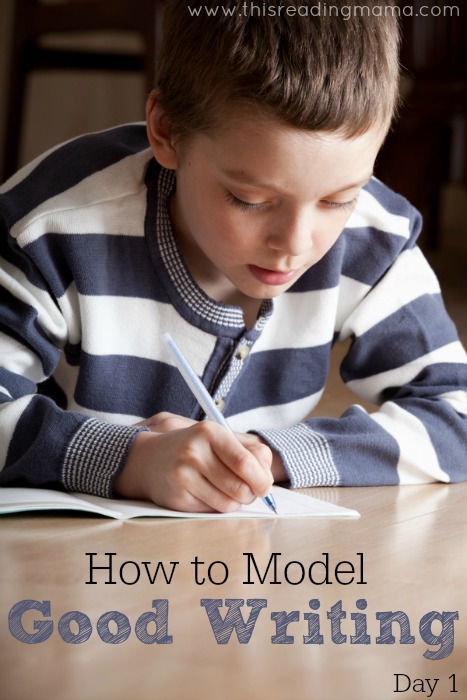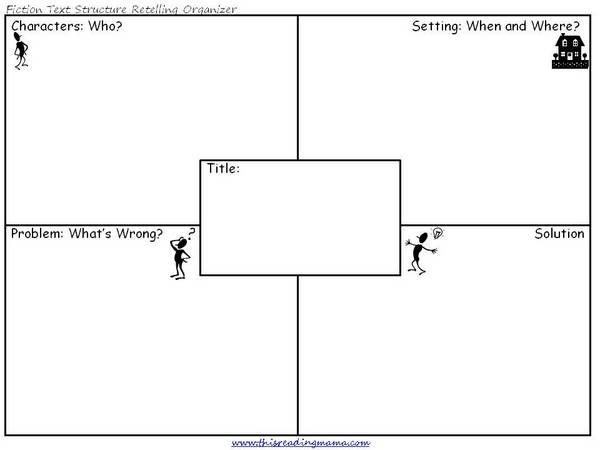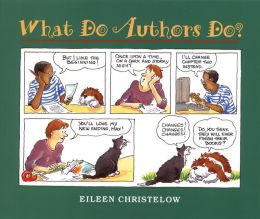Welcome to This Reading Mama! If you’re new, you’re just in time to start out a 5 day series with me {intended for kids in the elementary grades/middle grades} entitled Unleashing the WRITER in Your Child. Today, we will be begin by discussing how to model good writing. You can click on the image above or here to see the topics for the following four days. Please feel free to comment on these posts or take part in discussions on Facebook. I LOVE to talk about this subject and am striving to make it as tangible as possible.
As I’ve been collecting my thoughts and drafting them for each day, I realize that this series may not be as practical as my posts usually are. Don’t get me wrong. There will still be a lot of things that you can “take home”. My main goal is to challenge how you currently teach writing. My focus is on teaching the writer through the process of writing as a craft. Crafting gives kids choices, empowering them to be the authors of their own writing: from choosing their topics down to their word choices.
*This post contains affiliate links. To read more about this, see my disclosure policy.
Scaffolding the Writer
I sit down beside my son (1st grade) as I look at the fiction text graphic organizer. He is very familiar with this, as we have used it quite a bit in summarzing a ficiton text. I say, “As we’ve read fiction texts together, we’ve discussed some elements that a good story needs. Today, we’re going to work on writing a fiction story together. Oh, I’m so excited!”
I let him listen in on my thoughts as I brainstorm some possible characters for my story, the setting, a possible problem in the story, and a possible solution. I pick people from our family; people he has a vested interest in. I model how I jot these on the graphic organizer, scratching out something if I think of something else that clicks better. He jumps in to help in the process.
Modeling. Scaffolding. Our young writers need to hear us brainstorm. They need to see us wrestling with the text, making decisions along the way. To keep or not to keep? To continue or go in a different direction? What is my purpose in writing? For whom am I writing? Writing is very much like reading comprehension. Much of it is done silently; unless we intentionally make our thinking “visible”.
“We don’t find many teachers of oil painting, piano, ceramics, or drama who aren’t participants in their fields. Their students see them in action in the studio. They can’t teach without showing what they mean. There is a process to follow. There is a process to learn. That’s the way it is with craft, whether it be teaching or writing.” – D. Graves, Writing: Teachers & Children at Work
And don’t fret about your level of ability. Penny Kittle claims “you really only need to write a little better… in order to lead someone else to a new understanding about writing”. When teaching writing as a craft, the teacher and the student are peer authors; both serving in roles as the teacher at times. “Modeling changes my relationship with [my child]. We become writers together.” Graves
Modeling through Read Alouds
If you feel somewhat intimidated about modeling writing with your child, pick up a good book and discuss good writing as you read aloud. For example, my son and I are currently into the Magic Tree House books. When we get to the end of each chapter, he is not satisfied. He wants me to keep reading and gets upset when I stop. If it were up to him, he’d have me read the entire book in one sitting. One day, I asked him, “Have you noticed what the author does at the end of each chapter? She leaves you ‘hanging’. And when she leaves you ‘hanging’, that makes you want to read more. I wonder why she wrote it like that?” We had a lovely discussion about author’s craft, the decision to leave each chapter open so the reader would WANT to keep going. For more examples, visit Jodie’s post on Ten Mentor Texts for Modeling Writing.
{photo credit}
“[Children] need to be surrounded with poetry, stories, information books, biography, science and history, imaginative and factual books. Children need to hear, speak, and read literature.” –Graves
Children’s literature has so many great things to teach us as readers: author’s craft, use of imagery, the power of persuasion, showing not telling, use of character, point of view, etc…all things that we may connect to reading comprehension; but we also need to connect those concepts to our own writing.
Find a Local Author
A very powerful tool in modeling the writing process is to find a local author and let your child spend some time with him/her. If you’re a part of a local homeschooling community, this is something that would benefit all young writers. If you’re not sure of any local authors, call your local library to see if they have a list. They may even have upcoming events featuring local authors.
I’ll never forget the day an author came to the school in which I used to teach. I knew there would be a Q & A time at the end so I prepped my kids by brainstorming some questions we could ask the author. My students were very familiar with the writing process as we did Writer’s Workshop every day. I still remember vividly one of my students asking, “How many times do you revise your work before you publish?” The author’s answer shocked my whole class, including me. “Sometimes it takes 50 times before I get it like I like it.” I think all my students’ jaws dropped. You can bet we had some great discussions when we came back to the classroom.
Learn about the Life of an Author
If you’re not able to locate a local author, there are some GREAT books that tell about the process of an author. I’ve used several of these when teaching the writing process.
- Arthur Writes a Story by Marc Brown
- Author: A True Story by Helen Lester
- If You Were a Writer by Joan Lowery Nixon
- Rocket Writes a Story by Tad Hills (geared for younger elementary)
- Voices in the Park by Anthony Browne
- What do Authors Do? by Eileen Christelow
Another option is to hop online and research your favorite author. Tomie dePaola’s life is an interesting one to research. You may also be able to locate email addresses of favorite authors and email them. It is amazing the access we have with the internet!
What Kinds of Things do I Model?
As you observe your young writer, look for things he uses, but confuses. Does he have a hard time staying on topic as he writes? Start there. Does she tend to use run-on sentences? Start there. Keep a notebook yourself to jot ideas down for the areas that your young writer needs a little extra support. Lucy Calkins, in her book, The Art of Teaching Writing suggests you ask yourself this simple question, “What is the one thing I can suggest or demonstrate that might help them most?” (pg. 194)
Here are a few more suggestions from Lucy Calkins (this is by no means an exhaustive list):
- different kinds of writing (friendly letter, a list, non-fiction, narrative, etc.)
- how to listen for sounds in words and invent spellings
- how to re-read what you wrote the day before to know where to start writing again
- how to think of a good beginning to a story to “hook” the audience
- picking a title for your story
- how to make mental images of the picture I want to include in my book
- choosing a different word (such as overjoyed instead of happy)
- procedures of writing process (what do you do when you are stuck, where do you get paper without asking for help, etc.)
- things to include in a Writer’s Notebook (we’ll talk about this tomorrow)
I’d love to hear your thoughts on modeling writing! Please share in the comments or on Facebook.
Check out more 5-day series posts from the bloggers at iHomeschool Network. I’m especially excited to see the FREE printables Ami has for the BOB Books, Set 2!
~Becky





Great tips!! I need to send my little writers over to your workshop. Anything past there names around here usually warrants tears 🙁 Oh, the mama drama!
Amber, you crack me up! There’s no shortage of mama drama over here some days.
Fantastic post! I’m getting ready to share this post on Facebook.
Thanks, Jodie! 🙂
Really love this series & need it right now. My son loathes writing, so I will definitely be using your ideas & tips!!!
You mentioned that this may not have a lot of “take home,” but I took home a LOT!!! Thanks for sharing! Love the suggestions!
I loved this post and am so excited to have found this series that you have done. We are struggling with writing and I need new ideas and/or a different perspective. Thank you for this post full of many ideas and resources to get us moving in a different direction.
Yay! So glad you can find new ideas and resources in this series. It was such a FUN one to write with The Measured Mom.
An awesome resource for connecting young writers with real authors is the Read-Aloud Revival. Every month there is an author event online and members get to hear from and ask questions of real, live authors. It is amazing! After the first author event my reluctant-writer kindergartener wanted to write a story. She sat right down and wrote and illustrated four pages about her loose tooth. Was she ever inspired!!!! Check it out at amongstlovelythings.com – well worth the investment.
I’ll have to check that out!